When you enter a store, you can ask the sales assistant to help you find what you need. But that’s not the case when you buy at an ecommerce store, and some people miss this aspect of shopping.
Still, you have a way to provide it to them.
Tailored product suggestions streamline consumers’ browsing experience and guide them toward relevant purchases. This has spurred a significant evolution from traditional, static recommendation engines to sophisticated, interactive solutions powered by artificial intelligence.
And this is where product recommendation chatbots come in.
This article explores the functionality of these virtual assistants, the benefits they offer to both businesses and consumers, and their growing role in shaping the future of online retail.
Set up a product recommendation chatbot in mere minutes
What is a product recommendation chatbot?
A product recommendation chatbot is an AI-powered conversational assistant designed to help users find products that match their preferences. Unlike static product suggestion algorithms, like You might also like sections at the bottom of the page, these chatbots engage users in natural conversation to deliver personalized product suggestions in real time.
Product recommendation chatbots are often integrated with ecommerce platforms like Shopify, WooCommerce, and Adobe Commerce to enable real-time access to product catalogs and inventory data. On top of that, this software connects with live chat and CRM tools for personalization based on customer segmentation and previous interactions.
So, how do these chatbots differ from standard recommendation tools?
Here are the main differences between a traditional recommendation system and a chatbot-based system:
| Feature | Traditional recommendation system | Chatbot-based recommendation system |
|---|---|---|
| Interface | Static | Conversational |
| Personalization | Based on past behaviour filtering | Real-time preference gathering via dialogue |
| User engagement | Passive | Active |
| Adaptability | Often fixed rules and filters | Adapts dynamically to input |
| Contextual understanding | Limited | Context capture through natural language |
So, how does a product recommendation chatbot work?
Product recommendation engines use algorithms and data to analyze user behavior and suggest items that are most likely to interest them. These engines aim to replicate the in-store experience of a knowledgeable sales assistant.
This system typically collects input through conversational flow that asks guided questions. Then, the recommendation engine uses the input combined with other data to offer suggestions. Once the bot sends recommendations, users can click through recommended items, view details, or ask follow-up questions.
Importance of personalized recommendations
Real-time recommendations capture intent, adapt instantly, and boost engagement. This helps the software recommend relevant products and react to behavior changes in-session to avoid irrelevant suggestions.
And, as you already know, personalization is key in today’s ecommerce. One-size-fits-all is outdated. Instead, personalized suggestions resonate more and lead to higher conversion. In fact, 63% of marketers saw an increase in conversions after implementing a personalized approach. On top of that, a customized experience builds trust and loyalty. It lets customers feel understood, not bombarded with irrelevant products.
Benefits of product recommendation chatbots
These bots can:
Boost in conversion rates
Personalized, real-time recommendations increase the likelihood of purchase by presenting the right product at the right time. Studies show that websites with personalized recommendation features have up to 4.5 times higher conversion rates compared to websites that don’t offer that feature.
Increase average order value (AOV)
Chatbots can suggest complementary products or upgrades, encouraging users to spend more.
And studies show that when prospects engage with a product recommendation engine, the AOV increases by 369%.
Reduce bounce rates
Engaging users immediately helps retain their attention and reduces the chances of them leaving the site prematurely. In fact, personalized content and recommendations decrease bounce rate by up to 45%.
Provide 24/7 assistance
Unlike human agents, chatbots are always available, supporting global customers across time zones. And this is important as 75% of customers expect brands to offer 24/7 assistance.
Improve customer satisfaction
Quick, relevant suggestions foster a more pleasant shopping experience and encourage return visits. For example, Wulff Beltton boosted customer satisfaction and increased client ratings to 4.5/5 after implementing chatbots.
Product recommendation examples: chatbots in action
Product recommendation chatbots, powered by AI models, are rapidly transforming online shopping by offering personalized guidance. This automation not only enhances the customer experience but also streamlines customer support workflows.
From suggesting the ideal shade of lipstick to recommending the perfect running shoes, these intelligent virtual assistants are optimizing the buying journey and improving customer engagement levels.
Here are use cases of product recommendation chatbots:
KOWO
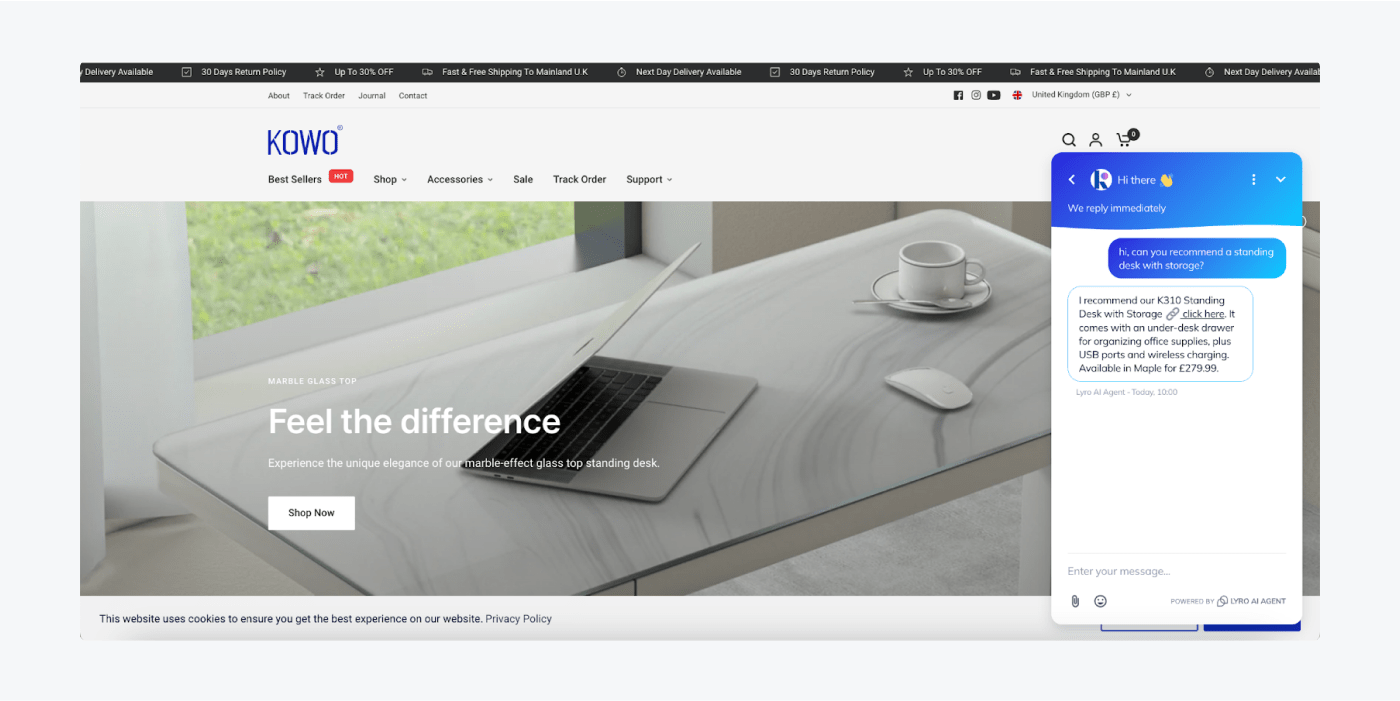
KOWO is a company dedicated to enhancing modern workspaces with innovative furniture solutions. It’s most notable for the range of height-adjustable standing desks. The product line offers desks with features like tempered glass tops with marble finishes and solid metal frames for stability. On top of that, this company provides desks with smart control panels that include USB ports, memory height settings, wireless charging, and child lock systems.
This furniture business uses a product recommender system to let customers find relevant products that match their needs. When you visit this brand’s website, you can engage with the chatbot and get suggestions for a desk perfect for you.
Ninja Transfers
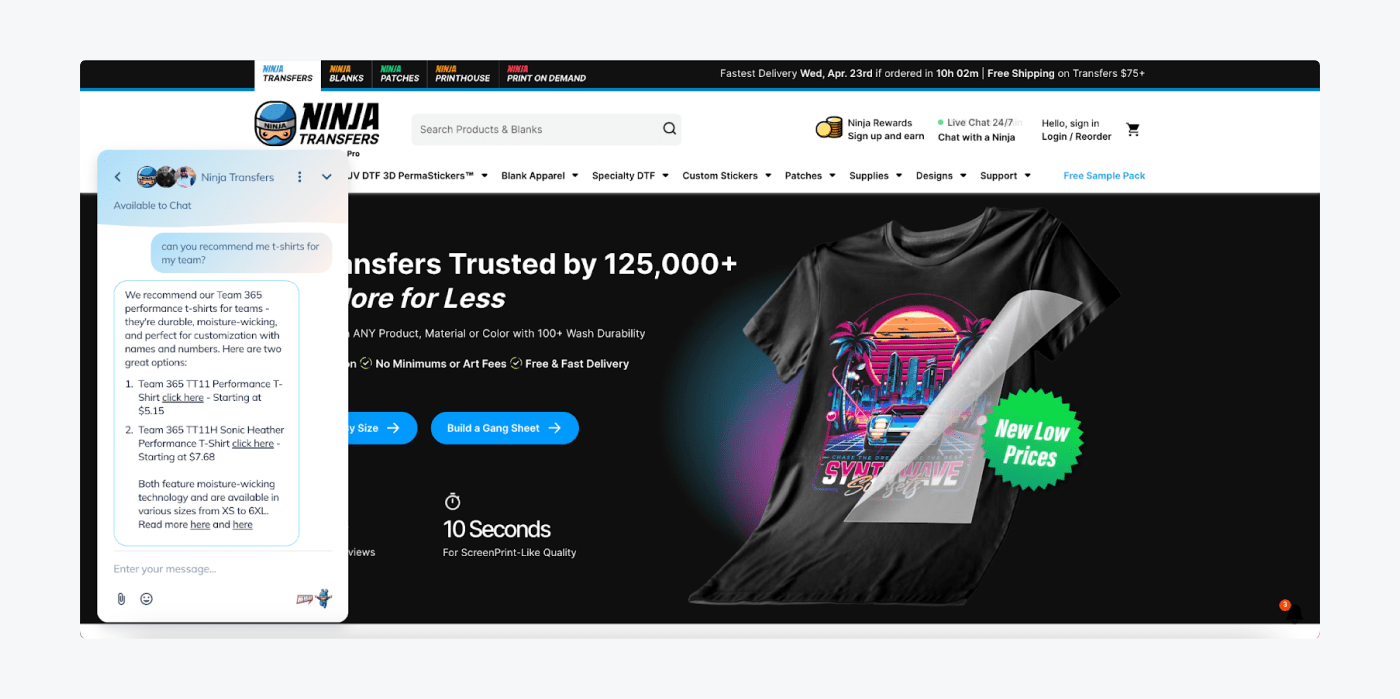
Ninja Transfers is a leading provider of custom DTF (Direct to Film) transfers. This company helps individuals, small businesses, and large-scale print shops bring their designs to life with exceptional quality and ease. Nina Transfers specializes in producing vibrant, durable, and stretchable transfers that can be applied to virtually any fabric or product, regardless of color or material.
You can ask the chatbot about the products you’re searching for, and it will give you suggestions with links to the product page. It helps to make the shopping experience smooth and provides links with additional information if the visitor would like to find out more about the items.
Cones Only
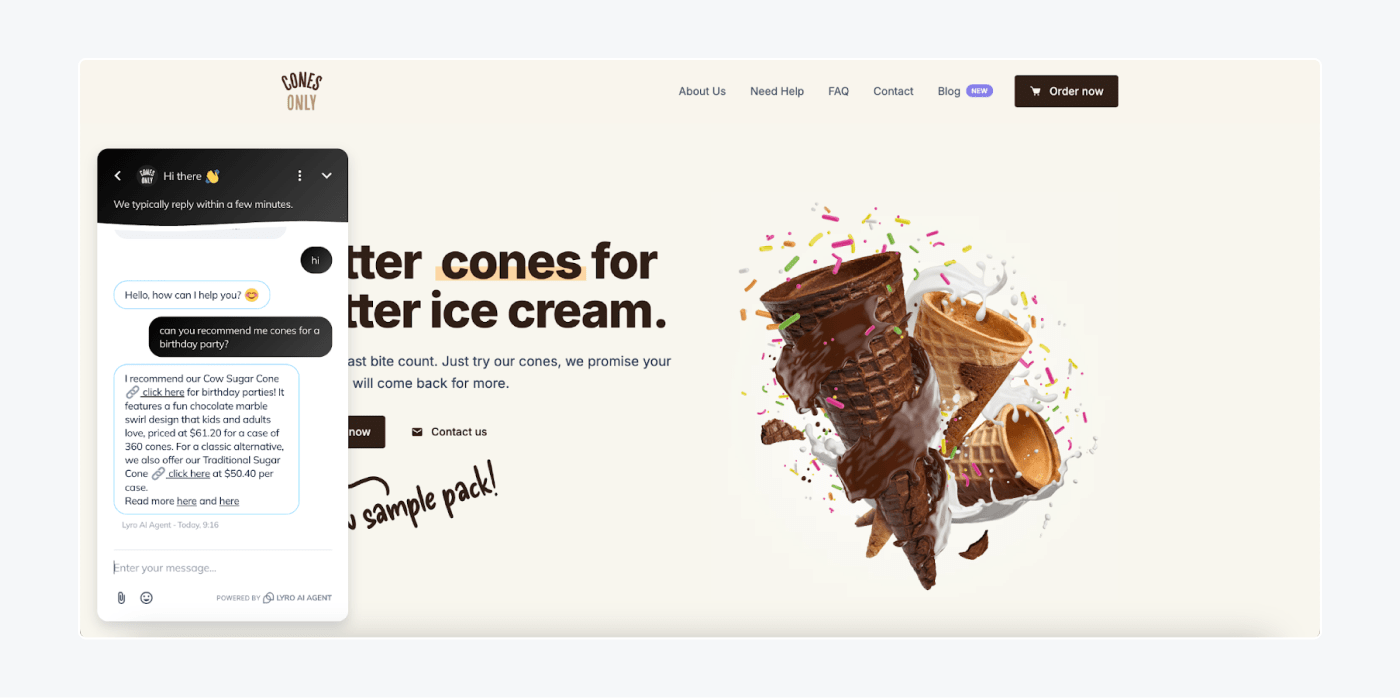
Cones Only has a mission to make the last bite count. From classic sugar and waffle cones to inventive twists like the Tropical Sugar Cone and the fun, kid-friendly Cow Sugar Cone.
You can ask the product recommendation chatbot on Cones Only’s website about specific cones you need. Whether you have a birthday party planned or want to get some cones for your child’s sleepover, Tidio’s Lyro AI will suggest options right for your needs. On top of that, the chatbot provides links so you can easily find the recommended products.
KichKing
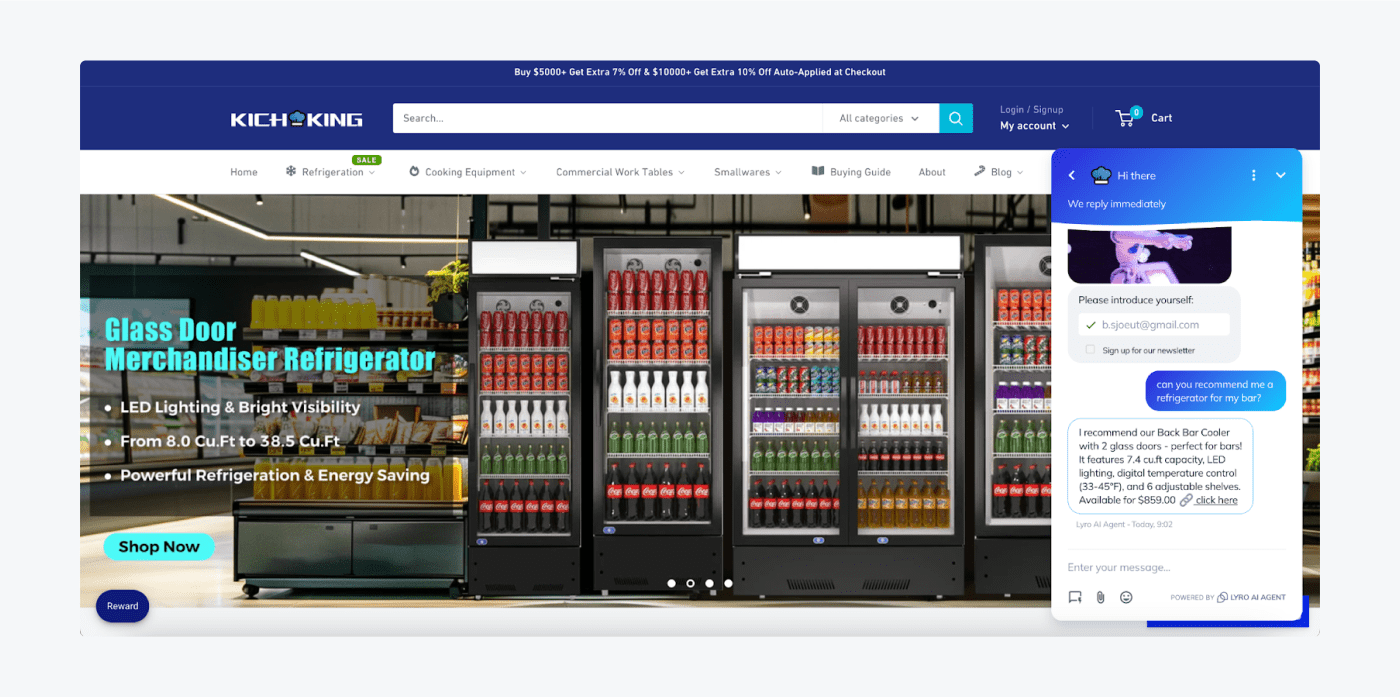
KitchKing is a leading provider of high-quality commercial kitchen appliances. This company specializes in merchandiser refrigerators, reach-in freezers, and compact bar coolers designed for both commercial and home use. Backed by responsive customer service and fast U.S. shipping, customers praise KitchKing for its product durability and value for money.
Their chatbot welcomes visitors. Then, to start chatting with the virtual shopping assistant, you provide your email address, which automatically collects leads for the company. The AI chatbot then offers support in finding the right kitchen appliance for your needs and provides brief product information.
How to build a product recommendation chatbot
Creating a product recommendation chatbot involves a structured approach, starting with exploring available chatbot templates to speed up development. The core functionality relies on effectively utilizing customer datasets to power the ecommerce product recommendation engine.
To ensure optimal performance, it’s crucial to define and track relevant metrics, allowing for continuous efforts to optimize the NLP chatbot‘s ability to drive conversions. When selecting a platform, carefully evaluate the specific features offered by the provider.
Some of the key features of a product recommendation chatbot you should keep an eye out for include:
- Conversational product discovery: Engages users with friendly, guided conversations
- Personalization engine: Tailors recommendations based on user preferences, past purchases, and demographics
- Cross-selling and upselling logic: Suggests complementary products and recommends higher-value alternatives
- Multichannel availability: Works across website chat widgets, mobile apps, Facebook Messenger, WhatsApp, and more
- 24/7 Availability: Handles peak traffic or after-hours inquiries without needing human support
- Integration with ecommerce and backend systems: Connects to platforms like Shopify or WooCommerce to fetch live product data and sync with user accounts
- Analytics and reporting: Tracks conversion rates, interactions, and popular product recommendations
Now—
Here’s a short tutorial on how to start using a product recommendation chatbot.
When you’re using a chatbot platform that offers a product recommendation engine, it’s usually easy to turn it on. For example, with Lyro, the product recommendations feature is an integral part of the system. So, it’s available automatically to Tidio’s users.
To activate it, go to the Lyro AI Agent section and choose the Knowledge tab. Click on the Data Sources and open the Products tab.
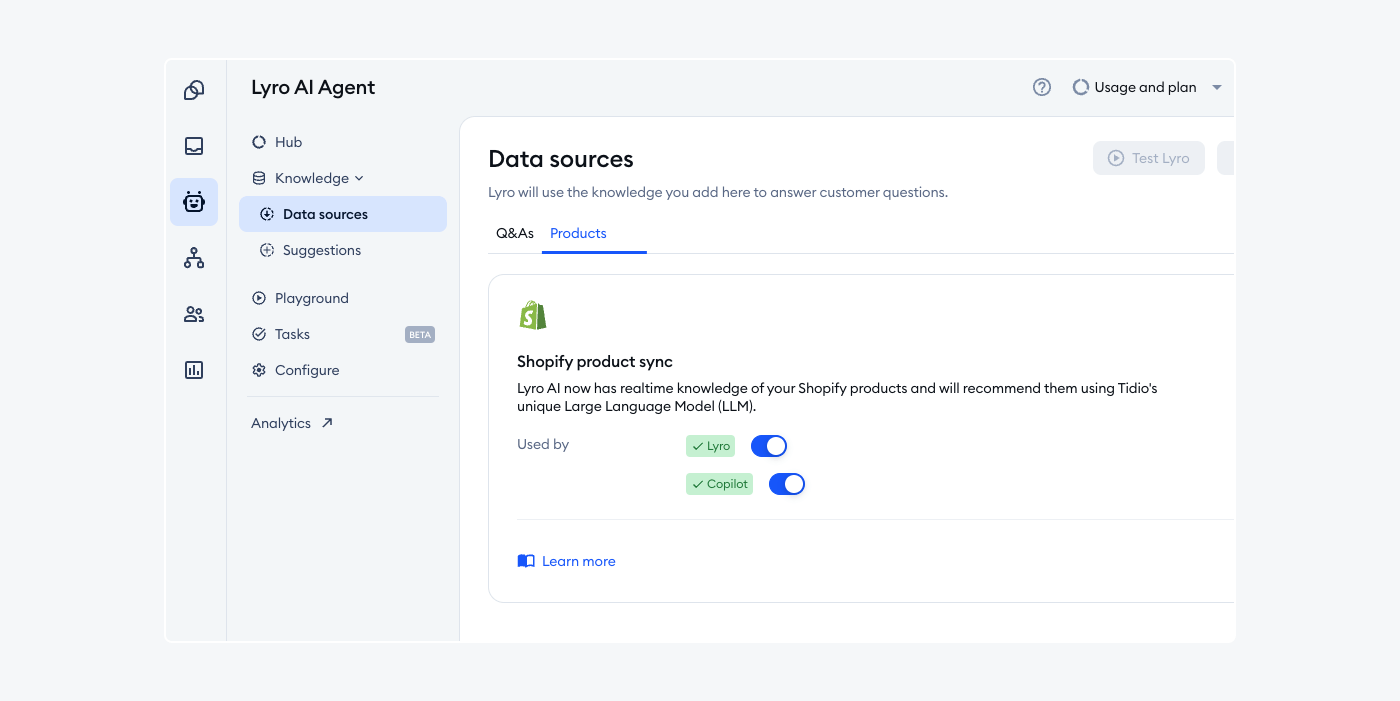
Keep in mind that this tab is only available when you integrate your Tidio platform with your Shopify store.
So, once you switch both of the toggles on, you’ll see the status of the products imported from your Shopify store. Once everything is enabled and you check that the information is up-to-date, Lyro will automatically start recommending products to your customers.
Read more: Learn how the Lyro product recommendation engine works.
Recommend products in real time
The integration of chatbot technology into your ecommerce platforms helps you provide smarter, more personalized customer experiences. By leveraging AI to understand customer inquiries and product details, you can transform simple interactions into valuable sales opportunities.
When you implement the product recommendation chatbot on your site, it offers suggestions to customers that match their needs and price range. This showcases the potential of this technology to enhance customer engagement and boost conversions.
For businesses seeking to harness the power of AI-driven product recommendations, Lyro emerges as an accessible and dependable solution. Its seamless integration with Shopify, automatic data synchronization, and intuitive management interface simplify the adoption process.
With Lyro, you can effortlessly import your existing product knowledge and empower the AI agent to deliver relevant and timely recommendations. Embracing chatbot technology like Lyro is a practical and readily available strategy for businesses aiming to provide truly intelligent and helpful product recommendations.
FAQs
A product recommendation chatbot is an AI agent that uses machine learning and natural language processing to suggest personalized products based on user preferences. It collects user input and delivers relevant recommendations, creating engaging, context-aware user experiences.
Product recommendation chatbots use machine learning to analyze user data and deliver personalized suggestions. They gather preferences, query a backend API, and present tailored products.
In ecommerce, product recommendations use AI to personalize suggestions based on a customer’s browsing history, behavior, and preferences.
Product recommendation algorithms use collaborative filtering, content-based filtering, and hybrid approaches to suggest relevant items. Collaborative filtering analyzes user behavior and similarities to recommend products based on what similar users liked. Content-based filtering focuses on product attributes like keywords or categories to find items a user may prefer. Hybrid systems combine both methods to improve accuracy.

